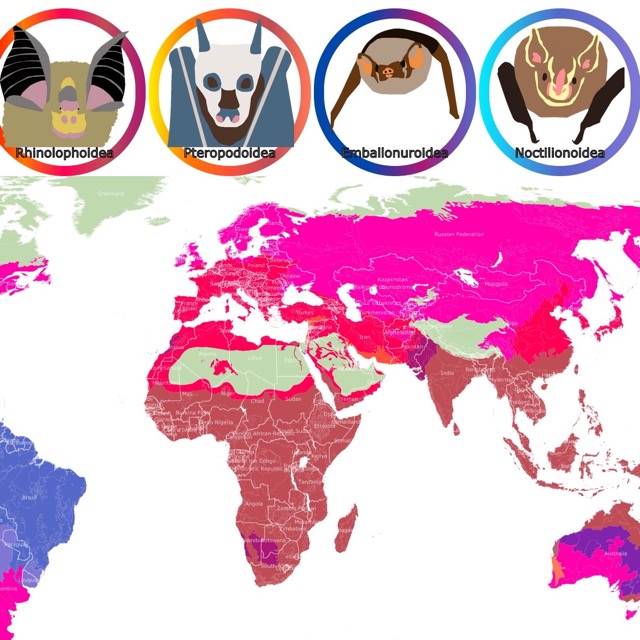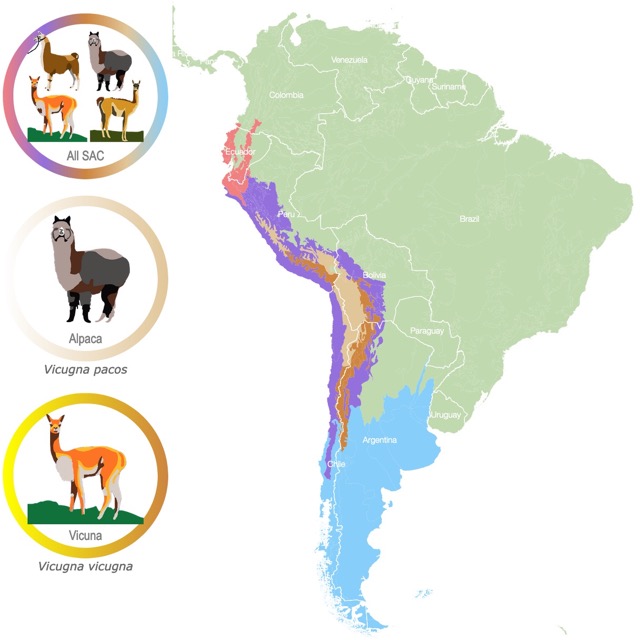Former and Current Tiger Subspecies Habitat Map
This ecoregion map shows the historical and current habitat of the subspecies of the Panthera tigris commonly known as tiger. Light colors represent the Former Habitat and dark colors represent the Current Habitat. Hover over the map to get detailed information from the tiger that has lived in a specific region.

Tiger Habitat
Tigers live in a wide variety of habitats. According to World Atlas these include:
- In India: tigers live in tropical moist broadleaf and dry forests, subtropical moist broadleaf forests, evergreen forests, and even the mangrove swamp forests.
- In India, Nepal and Bhutan: tigers live in subalpine forests.
- In Bangladesh: tigers live in Mangrove forests.
- In Indonesia: tigers are found in the montane and peat swamp forests.
- In Thailand: tigers occur in the evergreen and deciduous forests.
- In Russia: tigers live in the cold Siberian temperate broadleaf, Korean pine, and mixed forests.
- In Myanmar: tigers live in subtropical rain forests.
If you want to more facts about tigers and an indepth look at this species, Amazon has Tigers Mini Encyclopedia. In this book, you’ll discover how tigers are adapted for hunting and many other fascinating adaptation features!
Panthera Tigris
The largest of all the Asian big cats, tigers rely primarily on sight and sound rather than smell for hunting. They typically hunt alone and stalk prey. Their stripes act as camouflage in the long grass or wooded forests. They are seldom far from a water source.
As depicted in the ecoregions map above, the six subspecies live in a wide variety of habitats: flooded mangrove forests, arid forests, tropical forests, and taiga.
According to Fresno Chaffee Zoo, tigers usually attack prey from ambush and from the side or rear. After a kill, a tiger will drag prey into dense cover where it will continue to feed at its leisure.
Tigers drink frequently during a meal, so the prey is often hidden near water. All tigers readily enter water and, during the hot dry-season, Tigers spend much of the day resting near streams, often lying or standing in quiet water to keep cool.
There is no doubt that one of the greatest threats they face is their need for large contiguous areas of habitat, which support their requirements for prey and rearing of their offspring.
This habitat loss, is mainly due to habitat degradation for agriculture. Climate change is also causing ocean levels to rise, reducing coastal habitats occupied by tigers.
Felids are divided into two main groups. The purring cats are genus Felis and the roaring cats are genus Panthera. Felis is Latin for "cat" and panthera is Greek for "cat".
All tigers are subspecies of Panthera tigris. Of the known nine types of tigers or subspecies, the Balinese, Javan and Caspian are extinct. Source: Fresno Chaffee Zoo.
Indochinese Tiger
The Indochinese tiger Panthera tigris corbetti is about 20 percent smaller and darker than Bengal tiger, but larger than the Malayan tiger.
They have excellent hearing which also helps them detect prey such as deer, wild boar, monkeys, hog badgers, and even porcupines!
The strong back legs of this tiger allow it to easily jump onto high tree branches, swim, and chase prey. This tiger can run at speeds up to 60 miles per hour.
Indochinese tigers are solitary animals. The only time you'll see a few of these tigers together is when mothers are taking care of cubs and during mating season.
These tigers are shy and like to stay hidden from sight. But, a male will become aggressive to another male tiger entering its territory especially during mating season. Source: a-z Animals
It is estimated fewer than 1,500 Indochinese tigers are left in the wild. However since the tiger has a very wide range, it makes it difficult for researchers to determine their exact numbers.
Hunting for trophies, poaching by farmers, and the growing demand for tiger bones in Oriental medicine are key factors for the Indochinese tigers decline.
Tigers in Crisis states that their habitat is mostly made up of remote forests and hilly or mountainous terrain. Habitat loss due to population growth is also a major concern.
To learn more about tiger threats, Amazon has Tigers Forever: Saving the World's Most Endangered Big Cat. In this book, National Geographic photographer Steve Winter is on a one-man mission to address the plight of this magnificent cat.
Bengal Tiger
The Bengal, Indian, or Royal tiger Panthera tigris tigris is almost as large as the Siberian tiger. It is the most common subspecies of tiger. It is the national animal of India and Bangladesh.
Its skin shows a yellow to light orange color that in the belly and the internal areas of the legs becomes white or cream. Due to a genetic mutation, some specimens exhibit a white coat with dark stripes and blue eyes, but it is important to know that they are not albino tigers, just a genetic variety.
The power of the Bengal tiger is evident when observing its effectiveness at the time of hunting. This carnivorous animal, searches for medium or large prey, like ungulate mammals. In their diet, predominates the gaur, water buffalo, sambar, chital or mottled deer, wild boar and other species of deer. Bengal tigers can ingest up to 40 kilograms of food on a single occasion, although they usually consume a smaller amount.
According to Tigers-World, the main threats to this species are poaching and conflicts with humans over the territories. Poaching aim is to illegally trade the products obtained from tigers, such as decorative objects or the active ingredient of "drugs" to cure various diseases, but which have no proven efficacy.
India is now estimated to be home to around 70% of the world's tigers. It is home to nearly 3,000 tigers, a third more than it had four years ago, according to the latest tiger census. Source: BBC
The Bengal Tiger can be found in the deciduous forests (both wet and dry) of India; the hot, humid forests of Bhutan and the forests and grasslands of the Himalayas. As with other subspecies of tigers, Bengals prefer areas in which they are better concealed and camouflaged, always ready to take prospective prey by surprise. Source: Tigersthe most Majestic Cats in the World.
Sumatran Tiger
Sumatra or Sunda tiger Panthera tigris sondaica, is the smallest of all tiger subspecies and in captivity can weigh up to 140kg.
They have a more bearded and maned appearance than other subspecies. Sumatran tigers hunt wild pigs and deer but will take other prey opportunistically. Source: Fauna-Flora.org
According to WWF this subspecies was once found across several parts of the Sunda islands in Indonesia.
Today, all remaining Sunda tigers are found only in Sumatra, now that tigers in Java and Bali are extinct.
Sumatran tigers are distinguished by heavy black stripes on their orange coats. The last of the Sunda island tigers, estimated to be fewer than 400 today, are holding on for survival in the remaining patches of forest on the island of Sumatra.
Accelerating deforestation and rampant poaching mean this noble creature could end up extinct like its Javan and Balinese counterparts.
Malayan Tiger
Malayan Tiger Panthera tigris jacksoni lives in tropical and subtropical broadleaf forests. According to Alexandria Zoo their diet consists primarily of deer, antelope and wild pig, rarely taking smaller prey.
Classified as a separate subspecies from the Indochinese tiger in 2004, the Malayan tiger is found only in the southern Malay Peninsula.
Their wild population is unknown, but has been estimated at about 500 individuals.
Amur Tiger
The Amur or Siberian tiger Panthera tigris altaica is the largest subspecies. It is also the most pale and with least stripes, to help it blend in the snow. Because it lives in a colder climate it has the thickest coat.
Wild Cats Conservation says the average weight for males is 160-190 kg, while females are smaller, at 110-130 kg.
Males, females and cubs can be distinguished by their tracks: a male's paw pad measures 10.5 - 14.5 cm across, a female's 8.5 - 9.5 cm, and a cub's - from 5.5 - 10 cm. (Male cubs, after one year, usually have paw measurements already larger than their mothers').
Sexual maturity is reached around 4 years, but varies with gender and is earlier in zoo tigers. In the wild, they can live between 10-15 years, but in captivity, they live nearer to 20 years old.
In the 1940s, the Siberian tiger was on the brink of extinction with fewer than 50 individuals remaining in the wild. This was due to decades of almost continual political instability with the Russian Revolution and the formation of the Soviet Union. In 1947 after WW2, Russia became the first country to ban tiger hunting and offer tigers full protection.
Hunting of the main prey species, boar and deer, became restricted by annual quota based on the results of population counts.
You can read stories about the Siberian Tiger in this publication found on Amazon. Spirit of the Siberian Tiger: Folktales of the Russian Far East, has selected tales about tigers and aboriginal people of Russia's far east.
South China Tiger
The South China tiger Panthera tigris amoyensis is also known as Chinese tiger and Xiamen tiger and is one of the most endangered animals in the world and the most vulnerable of all Tigers.
In fact, this subspecies is already extinct in the wild, and only a few specimens are still alive in captivity.
At present, it is believed to be extinct in the wild, although there have been some indications and unconfirmed reports of possible specimens in the areas of Hubei, Yihuang, and Qizimei Nature Reserve.
Like all other subspecies, a carnivorous animal with a diet where predominate the ungulates (animals with hooves) typical of the region of southern China.
It consumes the following species: wild boars, muntjacs, Indian hog deer, gray langurs, wild pigs, porcupines, hares, tufted deer, sambar deer, serows, and even Indian peafowls. However, the small species are only a small part of their usual diet.
It is known to have attacked domestic cattle and humans as a consequence of the invasion of their natural habitat. It can consume from 18 to 40 kilograms in a single meal, after attacking its prey very stealthily usually from behind or the side. Source: Tigers-World
Even though the tiger is one of the twelve Chinese zodiac animals, and those born in the "Year of the Tiger" are thought to be brave, competitive and self-confident, the Chinese government ordered in the 1950s, that the South China tiger Panthera tigris amoyensis be destroyed because they were viewed as pests. Today, it is believed that the South China tiger is most likely extinct in the wild. Source: San Diego Zoo
Inspiration for Tiger Distribution Map
As most of humanity, I found myself staying home during the Coronavirus quarantine and watching more tv than expected. I am an avid Netflix user, but I rarely watch documentaries.
At some point everyone was talking about Tiger King, and I decided to watch and see what the fuss was all about. I definitely enjoyed the series, but I absolutely wanted to know more about captive exotic animals and specifically about tigers.
Looking more into tigers, I found that according to WWF there are more tigers in captivity than in the wild. Panthera tigris, the tiger species as a whole, is listed with a status of Endangered.
Furthermore, I was surprised to find out tigers kept in captivity, are a mixture of Asian tiger Subspecies. Among them, some subspecies are endangered and some are already extinct (see map above).
I found information on tigers is plentiful, but it is scattered and the maps lack information on the type of habitat tigers live in. A World Wildlife article mentions the type of habitats they live in, but the information is brief and not shown on a map.
With this map I wanted to answer a few questions. Where do tigers live? Where did tigers use to live? Where do tiger subspecies live? Do tiger subspecies distribution overlap?
Resources for Tiger Habitat Map
I found detailed facts on tiger subspecies and a map of their former and current ranges in an article on Genome-Wide Evolutionary Analysis of Natural History and Adaptation in the World's Tigers. Since the reason a species occupy a certain area is because of their physical characteristics, I decided I could incorporate this information to a biome or ecoregion map. I matched their approximate locations with a world ecoregions map. The shapefiles to create the map with the ecoregions of the world were obtained from WWF.
Data on tiger population subspecies number and status was gathered from San Diego Zoo Global Library and their fact sheet on tiger population: http://ielc.libguides.com/sdzg/ factsheets/tiger/population.
Dive in. There are so many areas with different characteristics, it is amazing to see how tigers managed to live in all of them at some point!
This map will be updated with improved and recent information! To receive updates on this and more nature maps join my email list!!!!!!!
Made by Luz K. Molina with D3.js.







